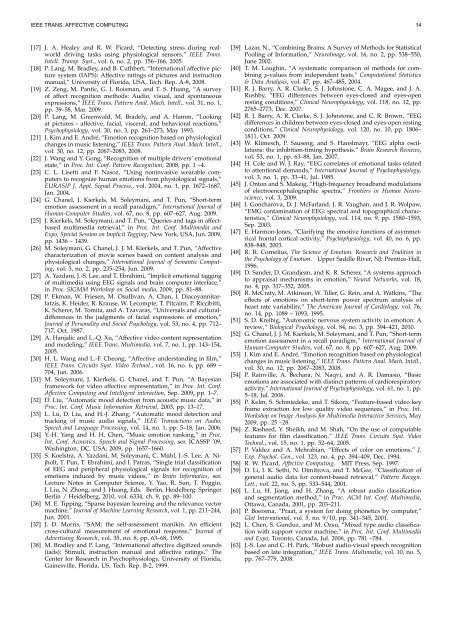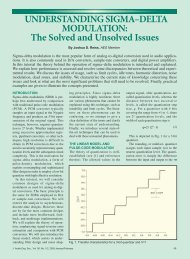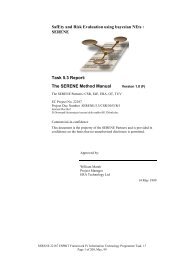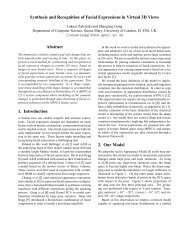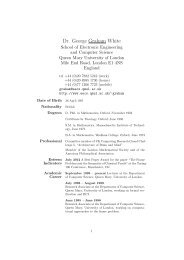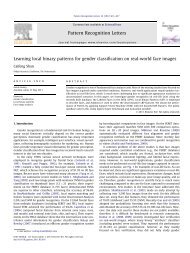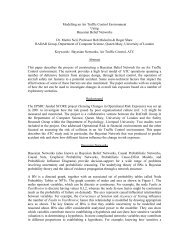DEAP: A Database for Emotion Analysis using Physiological Signals
DEAP: A Database for Emotion Analysis using Physiological Signals
DEAP: A Database for Emotion Analysis using Physiological Signals
Create successful ePaper yourself
Turn your PDF publications into a flip-book with our unique Google optimized e-Paper software.
IEEE TRANS. AFFECTIVE COMPUTING 14<br />
[17] J. A. Healey and R. W. Picard, “Detecting stress during realworld<br />
driving tasks <strong>using</strong> physiological sensors,” IEEE Trans.<br />
Intell. Transp. Syst., vol. 6, no. 2, pp. 156–166, 2005.<br />
[18] P. Lang, M. Bradley, and B. Cuthbert, “International affective picture<br />
system (IAPS): Affective ratings of pictures and instruction<br />
manual,” University of Florida, USA, Tech. Rep. A-8, 2008.<br />
[19] Z. Zeng, M. Pantic, G. I. Roisman, and T. S. Huang, “A survey<br />
of affect recognition methods: Audio, visual, and spontaneous<br />
expressions,” IEEE Trans. Pattern Anal. Mach. Intell., vol. 31, no. 1,<br />
pp. 39–58, Mar. 2009.<br />
[20] P. Lang, M. Greenwald, M. Bradely, and A. Hamm, “Looking<br />
at pictures - affective, facial, visceral, and behavioral reactions,”<br />
Psychophysiology, vol. 30, no. 3, pp. 261–273, May 1993.<br />
[21] J.KimandE.André,“<strong>Emotion</strong>recognitionbasedonphysiological<br />
changes in music listening,” IEEETrans.Pattern Anal. Mach. Intell.,<br />
vol. 30, no. 12, pp. 2067–2083, 2008.<br />
[22] J. Wang and Y. Gong, “Recognition of multiple drivers’ emotional<br />
state,” in Proc. Int. Conf. Pattern Recognition, 2008, pp. 1 –4.<br />
[23] C. L. Lisetti and F. Nasoz, “Using noninvasive wearable computers<br />
to recognize human emotions from physiological signals,”<br />
EURASIP J. Appl. Signal Process., vol. 2004, no. 1, pp. 1672–1687,<br />
Jan. 2004.<br />
[24] G. Chanel, J. Kierkels, M. Soleymani, and T. Pun, “Short-term<br />
emotion assessment in a recall paradigm,” International Journal of<br />
Human-Computer Studies, vol. 67, no. 8, pp. 607–627, Aug. 2009.<br />
[25] J. Kierkels, M. Soleymani, and T. Pun, “Queries and tags in affectbased<br />
multimedia retrieval,” in Proc. Int. Conf. Multimedia and<br />
Expo, Special Session on Implicit Tagging, New York, USA,Jun.2009,<br />
pp. 1436 – 1439.<br />
[26] M. Soleymani, G. Chanel, J. J. M. Kierkels, and T. Pun, “Affective<br />
characterization of movie scenes based on content analysis and<br />
physiological changes,” International Journal of Semantic Computing,<br />
vol. 3, no. 2, pp. 235–254, Jun. 2009.<br />
[27] A.Yazdani, J.-S.Lee,andT.Ebrahimi,“Implicit emotional tagging<br />
of multimedia <strong>using</strong> EEG signals and brain computer interface,”<br />
in Proc. SIGMM Workshop on Social media, 2009, pp. 81–88.<br />
[28] P. Ekman, W. Friesen, M. Osullivan, A. Chan, I. Diacoyannitarlatzis,<br />
K. Heider, R. Krause, W. Lecompte, T. Pitcairn, P. Riccibitti,<br />
K. Scherer, M. Tomita, and A. Tzavaras, “Universals and culturaldifferences<br />
in the judgments of facial expressions of emotion,”<br />
Journal of Personality and Social Psychology, vol. 53, no. 4, pp. 712–<br />
717, Oct. 1987.<br />
[29] A. Hanjalic and L.-Q. Xu, “Affective video content representation<br />
and modeling,” IEEE Trans. Multimedia, vol. 7, no. 1, pp. 143–154,<br />
2005.<br />
[30] H. L. Wang and L.-F. Cheong, “Affective understanding in film,”<br />
IEEE Trans. Circuits Syst. Video Technol., vol. 16, no. 6, pp. 689 –<br />
704, Jun. 2006.<br />
[31] M. Soleymani, J. Kierkels, G. Chanel, and T. Pun, “A Bayesian<br />
framework <strong>for</strong> video affective representation,” in Proc. Int. Conf.<br />
Affective Computing and Intelligent interaction, Sep. 2009, pp. 1–7.<br />
[32] D. Liu, “Automatic mood detection from acoustic music data,” in<br />
Proc. Int. Conf. Music In<strong>for</strong>mation Retrieval, 2003, pp. 13–17.<br />
[33] L. Lu, D. Liu, and H.-J. Zhang, “Automatic mood detection and<br />
tracking of music audio signals,” IEEE Transactions on Audio,<br />
Speech and Language Processing, vol. 14, no. 1, pp. 5–18, Jan. 2006.<br />
[34] Y.-H. Yang and H. H. Chen, “Music emotion ranking,” in Proc.<br />
Int. Conf. Acoustics, Speech and Signal Processing, ser. ICASSP ’09,<br />
Washington, DC, USA, 2009, pp. 1657–1660.<br />
[35] S. Koelstra, A. Yazdani, M. Soleymani, C. Mühl, J.-S. Lee, A. Nijholt,<br />
T. Pun, T. Ebrahimi, and I. Patras, “Single trial classification<br />
of EEG and peripheral physiological signals <strong>for</strong> recognition of<br />
emotions induced by music videos,” in Brain In<strong>for</strong>matics, ser.<br />
Lecture Notes in Computer Science, Y. Yao, R. Sun, T. Poggio,<br />
J. Liu, N. Zhong, and J. Huang, Eds. Berlin, Heidelberg: Springer<br />
Berlin / Heidelberg, 2010, vol. 6334, ch. 9, pp. 89–100.<br />
[36] M. E. Tipping, “Sparse bayesian learning and the relevance vector<br />
machine,” Journal of Machine Learning Research, vol. 1, pp. 211–244,<br />
Jun. 2001.<br />
[37] J. D. Morris, “SAM: the self-assessment manikin. An efficient<br />
cross-cultural measurement of emotional response,” Journal of<br />
Advertising Research, vol. 35, no. 8, pp. 63–68, 1995.<br />
[38] M. Bradley and P. Lang, “International affective digitized sounds<br />
(iads): Stimuli, instruction manual and affective ratings,” The<br />
Center <strong>for</strong> Research in Psychophysiology, University of Florida,<br />
Gainesville, Florida, US, Tech. Rep. B-2, 1999.<br />
[39] Lazar, N., “Combining Brains: A Survey of Methods <strong>for</strong> Statistical<br />
Pooling of In<strong>for</strong>mation,” NeuroImage, vol. 16, no. 2, pp. 538–550,<br />
June 2002.<br />
[40] T. M. Loughin, “A systematic comparison of methods <strong>for</strong> combining<br />
p-values from independent tests,” Computational Statistics<br />
& Data <strong>Analysis</strong>, vol. 47, pp. 467–485, 2004.<br />
[41] R. J. Barry, A. R. Clarke, S. J. Johnstone, C. A. Magee, and J. A.<br />
Rushby, “EEG differences between eyes-closed and eyes-open<br />
resting conditions,” Clinical Neurophysiology, vol. 118, no. 12, pp.<br />
2765–2773, Dec. 2007.<br />
[42] R. J. Barry, A. R. Clarke, S. J. Johnstone, and C. R. Brown, “EEG<br />
differences in children betweeneyes-closed and eyes-open resting<br />
conditions,” Clinical Neurophysiology, vol. 120, no. 10, pp. 1806–<br />
1811, Oct. 2009.<br />
[43] W. Klimesch, P. Sauseng, and S. Hanslmayr, “EEG alpha oscillations:<br />
the inhibition-timing hypothesis.” Brain Research Reviews,<br />
vol. 53, no. 1, pp. 63–88, Jan. 2007.<br />
[44] H. Cole and W. J. Ray, “EEG correlates of emotional tasks related<br />
to attentional demands,” International Journal of Psychophysiology,<br />
vol. 3, no. 1, pp. 33–41, Jul. 1985.<br />
[45] J. Onton andS. Makeig, “High-frequency broadbandmodulations<br />
of electroencephalographic spectra,” Frontiers in Human Neuroscience,<br />
vol. 3, 2009.<br />
[46] I. Goncharova, D. J. McFarland, J. R. Vaughan, and J. R. Wolpaw,<br />
“EMG contamination of EEG: spectral and topographical characteristics,”<br />
Clinical Neurophysiology, vol. 114, no. 9, pp. 1580–1593,<br />
Sep. 2003.<br />
[47] E. Harmon-Jones, “Clarifying the emotive functions of asymmetrical<br />
frontal cortical activity,” Psychophysiology, vol. 40, no. 6, pp.<br />
838–848, 2003.<br />
[48] R. R. Cornelius, The Science of <strong>Emotion</strong>. Research and Tradition in<br />
the Psychology of <strong>Emotion</strong>. Upper Saddle River, NJ: Prentice-Hall,<br />
1996.<br />
[49] D. Sander, D. Grandjean, and K. R. Scherer, “A systems approach<br />
to appraisal mechanisms in emotion,” Neural Networks, vol. 18,<br />
no. 4, pp. 317–352, 2005.<br />
[50] R. McCraty, M. Atkinson, W. Tiller, G. Rein, and A. Watkins, “The<br />
effects of emotions on short-term power spectrum analysis of<br />
heart rate variability,” The American Journal of Cardiology, vol. 76,<br />
no. 14, pp. 1089 – 1093, 1995.<br />
[51] S. D. Kreibig, “Autonomic nervous system activity in emotion: A<br />
review,” Biological Psychology, vol. 84, no. 3, pp. 394–421, 2010.<br />
[52] G.Chanel,J.J.M.Kierkels, M.Soleymani,andT.Pun,“Short-term<br />
emotion assessment in a recall paradigm,” International Journal of<br />
Human-Computer Studies, vol. 67, no. 8, pp. 607–627, Aug. 2009.<br />
[53] J.KimandE.André,“<strong>Emotion</strong>recognition basedonphysiological<br />
changes in music listening,” IEEETrans.Pattern Anal. Mach. Intell.,<br />
vol. 30, no. 12, pp. 2067–2083, 2008.<br />
[54] P. Rainville, A. Bechara, N. Naqvi, and A. R. Damasio, “Basic<br />
emotionsare associated with distinctpatternsof cardiorespiratory<br />
activity.” International Journal of Psychophysiology, vol.61, no. 1, pp.<br />
5–18, Jul. 2006.<br />
[55] P. Kelm, S. Schmiedeke, and T. Sikora, “Feature-based video key<br />
frame extraction <strong>for</strong> low quality video sequences,” in Proc. Int.<br />
Workshop on Image <strong>Analysis</strong> <strong>for</strong> Multimedia Interactive Services, May<br />
2009, pp. 25 –28.<br />
[56] Z. Rasheed, Y. Sheikh, and M. Shah, “On the use of computable<br />
features <strong>for</strong> film classification,” IEEE Trans. Circuits Syst. Video<br />
Technol., vol. 15, no. 1, pp. 52–64, 2005.<br />
[57] P. Valdez and A. Mehrabian, “Effects of color on emotions.” J.<br />
Exp. Psychol. Gen., vol. 123, no. 4, pp. 394–409, Dec. 1994.<br />
[58] R. W. Picard, Affective Computing. MIT Press, Sep. 1997.<br />
[59] D. Li, I. K. Sethi, N. Dimitrova, and T. McGee, “Classification of<br />
general audio data <strong>for</strong> content-based retrieval,” Pattern Recogn.<br />
Lett., vol. 22, no. 5, pp. 533–544, 2001.<br />
[60] L. Lu, H. Jiang, and H. Zhang, “A robust audio classification<br />
and segmentation method,” in Proc. ACM Int. Conf. Multimedia,<br />
Ottawa, Canada, 2001, pp. 203–211.<br />
[61] P. Boersma, “Praat, a system <strong>for</strong> doing phonetics by computer,”<br />
Glot International, vol. 5, no. 9/10, pp. 341–345, 2001.<br />
[62] L. Chen, S. Gunduz, and M. Ozsu, “Mixed type audio classification<br />
with support vector machine,” in Proc. Int. Conf. Multimedia<br />
and Expo, Toronto, Canada, Jul. 2006, pp. 781 –784.<br />
[63] J.-S. Lee and C. H. Park, “Robust audio-visual speech recognition<br />
based on late integration,” IEEE Trans. Multimedia, vol. 10, no. 5,<br />
pp. 767–779, 2008.


